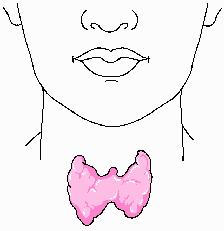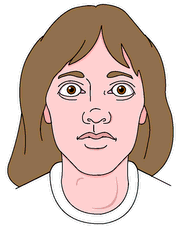

Your thyroid gland is a small, butterfly-shaped gland located just
below your Adam's apple.  The thyroid produces hormones that affect your body's metabolism and energy
level. Thyroid problems are among the most common medical conditions but,
because their symptoms often appear gradually, they are commonly misdiagnosed.
The thyroid produces hormones that affect your body's metabolism and energy
level. Thyroid problems are among the most common medical conditions but,
because their symptoms often appear gradually, they are commonly misdiagnosed.
The three most common thyroid problems are the underactive
thyroid, the overactive
thyroid , and thyroid
nodules.
The most common cause of hypothyroidism is Hashimoto's thyroiditis. In
this condition, the body's immune system mistakenly attacks the thyroid gland.
Common symptoms of hypothyroidism are:
|
 |
DIAGNOSIS of hypothyroidism is usually straightforward, once it is suspected. Patients with hypothyroidism due to Hashimoto's thyroiditis have an elevated level of serum TSH (thyroid stimulating hormone). However, the rare patient with hypothyroidism due to a pituitary or hypothalamic condition may have a normal or low serum TSH.
TREATMENT of hypothyroidism
consists of taking thyroid hormone in pill form on a daily basis. Symptoms of
hypothyroidism should clear up within a few months of starting treatment.
Adjustment of the dose of thyroid pills is based upon measurements of serum TSH.
Most patients need to take thyroid hormone for life.
The most common cause of hyperthyroidism is Graves' disease. This
occurs when the body's immune system overstimulates the
thyroid.
Common symptoms of hyperthyroidism
are:
|
 |
In addition to symptoms of hyperthyroidism, some patients with Graves' disease develop eye symptoms such as a stare, eye irritation, bulging of the eyes and, occasionally, double vision or loss of vision. Involvement of the eyes is called Graves' Ophthalmopathy.
DIAGNOSIS is straightforward if suspected. However, patients are sometimes evaluated for other conditions, such as cancer or heart problems, if the doctor doesn't think of hyperthyroidism. The diagnosis is best made by finding an elevated level of Free T4 and low level of TSH in the blood. A thyroid scan should then be performed to determine whether the hyperthyroidism is due to Graves' disease or another condition such as toxic multinodular goiter, hot nodule, subacute thyroiditis, or silent thyroiditis. There are other, rare, cases of hyperthyroidism that usually require the expertise of an endocrinologist for diagnosis.
Several methods of TREATMENT are available for hyperthyroidism.
The most popular method is radioactive
iodine.Because the thyroid is the only organ in the body that
takes up and uses iodine, when a dose of radioactive iodine is given the
radiation enters the thyroid and destroys part of it. The main side effect is
the development of an underactive thyroid which is treated as discussed above.
Medications can also be used for treatment. These drugs slow down the
working of thyroid and restore normal levels. However, they usually need to be
taken for 6-12 months and 60-80% of patients have a relapse when they stop
taking them. These drugs are associated with serious side effects in a small
percentage of patients taking them. Surgical removal
of part of the thyroid is occasionally used as a treatment.
Consultation with a thyroid specialist is highly recommended to determine
which treatment is best for you!
Thyroid nodules are fairly common and usually harmless. However, about 4% of nodules are cancerous, so further testing needs to be done. This is usually best accomplished by fine needle aspiration biopsy. This is a quick and simple test that takes just a few minutes to perform in the doctor's office. If the biopsy does not raise any suspicion of cancer, the nodule is usually observed. Some thyroid specialists recommend treatment with thyroid hormone to try to decrease the size of the nodule. A second biopsy is usually recommended 6-12 months later, to make sure there continues to be no evidence of cancer. If a nodule is cancerous, suspicious for cancer, or grows large enough to interfere with swallowing or breathing, surgical removal is advised.
Further reading. We highly recommend the following book written by three endocrinologists for patients with thyroid problems: Your Thyroid: A Home Reference by Woods, L.C., Cooper, D.S., and Ridgway, E.C., published by Ballantine Books. 0-345-39170-5
Diabetes and Hormone Center of the Pacific 1329 Lusitana Street, #304 Honolulu, HI 96813-2411 Tel: (808) 531-6886 Fax: (808) 523-5115![]() Your comments are welcomed. For medical questions consult your physician.
Your comments are welcomed. For medical questions consult your physician.
| © 1996 All Rights Reserved. David Fitz-Patrick, M.D. |